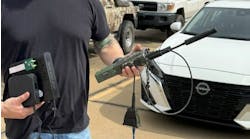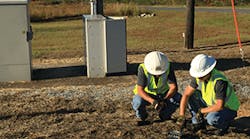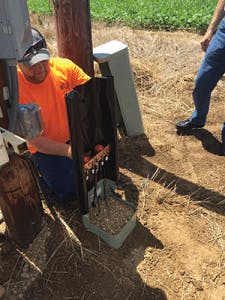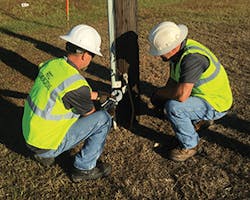Telephone Electronics Corp Gets It
Oftentimes we take our ground fields and our plant bonding for granted. However, in today’s high-speed data world, we cannot overlook how we are tied back to the earth and to the power companies.
With broadband becoming the pipeline for everything data into the home, it has become essential to do everything possible to insure that customers have good experiences and can perform needed tasks, from email to OTT video services. Even if you are not offering IPTV, you need to treat your plant with the same care to ensure that video streaming will work correctly, and that customers can depend on your services day in and day out.
As an incumbent local exchange carrier that serves several rural areas in Mississippi, Alabama, and Tennessee, we, at Telephone Electronics Corporation (TEC), realized this and started to make changes to our copper plant.
Although we want to provide everyone with fiber, because of our rural service area, delivery to some homes can be a bit tricky. Realizing this, we needed to evaluate all our options and come up with a plan about how to deliver services with the copper plant we already had in place.
After meeting with various vendors, along with key members of our technical staff, and doing some research, we decided that the first phase in our copper revitalization was to equip every technician with multi-function copper testers so they could isolate problems in the plant and correct them. These copper testers helped us to quickly identify noise and power influence in our plant.
Results gained from the testers showed us that we needed to implement a pedestal (ped) rehab program to verify that copper bonds were functional. We also needed to confirm that we were tying back to power grounds as often as possible (minimum 4 times per mile).
Getting With the Program
The comprehensive rehab program includes cleaning around the ped, dispensing rodent/insect protection,and verifying that all bonds are properly torqued to 40 inch-pounds. It also verifies that current is flowing on the bond using an AC clamp-on current meter that can measure milli-amps, as well as perform a visual inspection of the ped and splices.
Outside plant technicians are expected to perform at least 20 rehabs per month, either while out working on service calls or during down times of the day. We have found that most technicians can easily do more than the 20 that are expected per month by simply catching 1 or 2 during the course of a normal work day. Additionally, technicians are required to note the ped number and any issues that need to be addressed into the TEC ticketing system for tracking purposes.
Figure 1. Pedestal that TEC modified to be used exclusively for ground connections, this keeps all of the connections out of the remote cabinet and makes it much easier to access for testing. (Pictured is Dustin Pollard, TEC.)
Managers are able to view the route and ped number in a report that is published every month, using the ticketing system, showing each technician’s results. From the report, they are then able to see what areas are complete and those that need to be addressed. (See Figure 1.) Once the program was implemented and running smoothly, we quickly noticed that troubles were lower in areas where rehab work had been done. We also started to see that we could get higher data rates at longer distances. All of these factors contributed to better results on the DELT test and prequalification testing that is done using multi-function test sets. Together, these improvements resulted in a better experience for our customers.
Quieting the Noise
During rehab testing, we realized that there was still some noise and power influence issues in certain areas. We looked deeper into the situation and determined that we needed to verify proper ground fields at our central offices and remote cabinets. The objective was to find the least intrusive way to verify that ground fields were intact and performing to specifications. First, a baseline for each location needed to be established. Then annual readings needed to be taken using a ground meter to note any significant changes in ground readings. To help us with the readings, we chose the Megger DET24C clamp-on meter for its ease of use and ability to take readings at most locations without having to disconnect any ground connections.
Figure 2. Chris Harmon and Lee Bennett from TEC.
Even if you are 100% fiber distribution, inspecting your ground fields to protect your personnel and equipment is critical. (See Figure 2.) All readings are logged and tracked year to year. They are taken at the remote cabinet connection to the ground field. We read the ground resistance at the cross-connect and at the power ground. Our objective is to verify all readings are at the same potential, and have not seen substantial changes since the previous test. We also note soil conditions at time of test as moisture in the soil can impact ground readings.
The test has been very simple on straight line ground fields. However, we discovered an issue with finding a good way to take readings on sites where the ground field is in a ring configuration.
When using a clamp-on meter, a connection point is needed with a good return path through soil, and not just through ground wire. This is exhibited as some very low readings, such as <.20 Ohms. In applications where this arises, a real baseline reading is needed. To accomplish this, we used a 4-point ground tester. We verified that the power and cross-connect are tied to the same ground field. Once all of this is documented, the clamp-on tester is then used to confirm that all readings are unchanged year-to-year, as well as to spot issues and opens in the ground field. (See Figure 3.)
Figure 3. Lee Bennet and Chris Harmon from TEC taking readings in the field.
As we continued testing, we found that many of the ground fields were undocumented, and a little detective work was required to determine how the ground fields were designed and connected. This resulted in having to dig up some of them and expose how connections were made. This enabled us to validate that the various parts were properly connected and at the same potential.
Issues Exposed
We exposed a number of issues where our ground fields were not tied to the power ground, discovered ground rings that had been cut or disconnected, and found sites that did not have adequate ground fields readings of <25 Ohms. Each issue was addressed on a case-by-case basis.
In the end, testing the central offices and remotes created a lot of work the first year: clearing issues, and finding where the ground interruptions were. Now we are able to test more quickly and efficiently — and finding fewer issues as we go. Additionally, measurable improvements have been realized: less damage to our electronics from lightning and surges, as well as the achievement of better data rate and reach to our customers.
TEC has been very pleased with the results of our renewed focus on the plant and ground testing programs. We are confident that without this program we would not be able to serve our customers at the level at which they have become accustomed.
TEC, an innovative and independent company based in Mississippi, with offices in Alabama, Louisiana and Tennessee. TEC is committed to delivering reliable, customized communication services across the nation. For more information, please see www.tec.com, www.facebook.com/TECForYourLife, or www.linkedin.com/company/tec-inc.
Save








